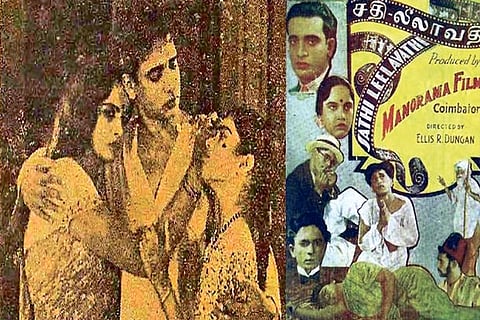

Chennai
IT’S not every day a movie is made that changes so many lives or the film industry. The year was 1937, six years after the silent movie became the Tamil talkie. People were still learning to make talkies and mistakes were costly affairs but already superstars like MKT had taken their due place. Ellis Roderick Dungan, an Irish American and an alumnus of the University of Southern California, moved to India in 1935 looking for chances to direct in the foundling cinema industry. He met his classmate Maniklal Tandon who promised to get him a chance.
AN Marudhachalam Chettiar, a leading film producer of the first decade of Tamil talkies was after Tandon, who had earlier made a movie Bhama Vijayam, for him to direct a new social movie. Bhama Vijayam, incidentally, had the entire cast singing Jana Gana Mana in the closing scenes — the first time the future anthem was ever recorded on the screen. And naturally, under the British rule, there was no government order for the audience to stand up in respect for the song. Tandon was busy directing Nandanar and recommended his friend Dungan to Chettiar. The latter saw the publicity potential of having an American direct a Tamil movie and assumed correctly that the language barrier could be bridged with Dungan easily. Dungan didn’t learn Tamil for the next 13 years and yet directed several masterpieces.
Marudhachalam liked the storyline of a stage play of Madurai Original Boys Company Pathi Bakthi (husband worship). The story goes like this — under the influence of alcohol, hero Krishnamurthy thrashes his friend who faints. Believing he has committed a murder, Krishnamurthy flees the land leaving behind his wife and daughter to suffer alone in poverty. But it happened that many producers were in a hunt for screen scripts and to his dismay, Marudhachalam learned that the play was already being filmed.
The disappointed producer was told that a magazine serial in Ananda Vikadan had a similar theme a couple of years before. The author was the owner of the magazine — SS Vasan — a jack of all trades and master of them too. Right from a fancy article salesman to a writer (his most popular book till then was a marriage manual — The Secrets of Married Life).
The transaction went ahead, the story rights were bought, the cast was assembled and Dungan commenced his first shoot. And then came a thunderbolt. The producers of Pathi Bakthi sensing that both the films would have similar storylines sued Marudhachalam for plagiarism. This was the first time litigation based on intellectual property rights was seen in the Madras courts.
Vasan was called to the witness box but he showed a book to the judge (an 1800’s American novel called Danesbury House) and acknowledged that he had lifted the story from it. Vasan insinuated that the Pathi Bakthi team could have done the same. The case ended with much laughter and red faces in court.
Released in 1936, Sathi Leelavathi was far from the royal or mythological themes that were the vogue that day. This social film centred around a long-suffering and virtuous spouse and included the prevalent Gandhian philosophies of prohibition, social justice and labour rights.
A young actor called Ramachandran acted in the film Pathi Bakthi when it was a stage play but was ignored for their film. He jumped camps and approached Marudhachalam for a role in Leelavathi. At first, he was offered a meatier role but the producers downscaled it soon. Ramachandran had to play a corrupt police officer called Rangaiah. Though he wasn’t happy and thought of turning it down, he accepted it on the advice of his mother. MGR nearly lost the role as well because the cop character rode a cycle and he did not know how to balance one. A compromise was suggested and Ramachandran seated on a cycle was pushed by a couple of men and the shot was made regardless of his plight at the end of the small journey.
Three top comedians of the Tamil cinema were introduced to the film world in this film — NS Krishnan, Balaiah and Thangavelu. The trio was responsible for laughter over half a century in the Tamil speaking regions. While two of them quickly learned the tricks of the trade, Thangavelu with an uncredited role in this movie had to wait for 17 years for his second chance in the silver screen. He even turned to beg at Palani temple as sustenance. Later, Thangavelu acted in 900 films.
There was no real competition from the Pathi Bakthi movie in the theatres and an overwhelming thumb’ up was given to Sathi Leelavathi. The World War that followed nearly snuffed out the industry. However, Dungan was active and directed 12 full-length Tamil movies and Ramachandran starred in five of them. After having been pulled to court, Vasan developed a deeper interest in filmmaking and bought a burnt down studio and renovated it and named it Gemini. After an 11-year hiatus and a series of supporting actor roles, MGR became a hero and then never looked back.
Sathi Leelavathi is remembered as the Tamil film that introduced so many stars including Dungan and Vasan who made sweeping changes in the way movies were made. The film also gave a break to MGR, who later became a demigod to his fans and political followers.
— The writer is a historian and author
Visit news.dtnext.in to explore our interactive epaper!
Download the DT Next app for more exciting features!
Click here for iOS
Click here for Android